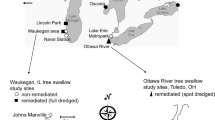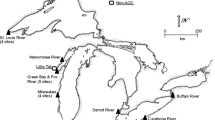Abstract
In this study, polychlorinated biphenyl (PCB) concentrations were measured in great blue heron (GBHE) (Ardea herodias) chicks and eggs at Crab Orchard National Wildlife Refuge (CONWR) in southern Illinois. In addition, biomagnification factors (BMFs) from gizzard shad (Dorosoma cepedianum) and their effects on reproductive effort were examined. Total PCBs (ΣPCBs) in chicks and shad were greater at the east end of Crab Orchard Lake (i.e., near the site of contamination) than the west end, but chick concentrations (4.1 to 10.1 mg/kg lipid weight) were lower than those typically associated with adverse effects. Chick BMFs based on shad from diet samples were greater than those based on shad collected from the lake. Furthermore, the two shad sources had dissimilar dioxin-like congener patterns and ΣPCBs, suggesting that there was variation in PCB load and composition and that the more contaminated shad were a small proportion of the actual heron chick diet. The number of eggs laid per nest was similar between colonies, suggesting no observable population level effects. Further study may be necessary to evaluate long-term effects on GBHEs at CONWR.


Similar content being viewed by others
References
Arenal CA, Halbrook RS (1997) PCB and heavy metal contamination and effects in European Starlings (Sturnus vulgaris) at a superfund site. Bull Environ Contam Toxicol 58:254–262
Arenal CA, Halbrook RS, Woodruff M (2004) European starling (Sturnus vulgaris): Avian model and monitor of polychlorinated biphenyl contamination at a superfund site in Southern Illinois, United States. Environ Toxicol Chem 23:93–104
Barnthouse LW, Glaser D, Young J (2003) Effects of historic PCB exposure on the reproductive success of the Hudson River striped bass population. Environ Sci Technol 37:223–228
Bosveld ATC, Gradener J, Murk AJ, Brouwer A, Van Kampen M, Evers EHG, et al. (1995) Effects of PCDDs, PCDFs, and PCBs in common tern (Sterna hirundo) breeding in estuarine and coastal colonies in The Netherlands and Belgium. Environ Toxicol Chem 14:99–115
Butler RW (1992) Great blue heron (Ardea herodias). In: Pool A, Stettenheim P, Gill F (eds) The birds of North America. The American Ornithologists’ Union, Washington, DC, pp 1–20
Custer TW, Hensler GL, Kaiser TE (1983) Clutch size, reproductive success, and organochlorine contaminants in Atlantic coast black-crowned night-herons. Auk 100:699–710
Custer TW, Hines RK, Stewart PM, Melancon MJ, Henshel DS, Sparks DW (1998) Organochlorines, mercury, and selenium in great blue heron eggs from Indiana Dunes National Lakeshore, Indiana. J Great Lakes Res 24:3–11
Gould JC, Cooper KR, Scanes CG (1997) Effects of polychlorinated biphenyl mixtures and three specific congeners on growth and circulating growth-related hormones. Gen Comp Endocrinol 106:221–230
Halbrook RS, Brewer RL Jr, Buehler DA (1999) Ecologic risk assessment in a large river-reservoir: 7. Environmental contaminant accumulation and effects in Great Blue Heron. Environ Toxicol Chem 18:641–648
Hite RL, King M (1977) Biologic investigation of the Crab Orchard Creek basin, summer 1975. Illinois Environmental Protection Agency, Illinois
Jenssen BM, Nilssen VH, Murvoll KM, Skaare JU (2001) PCBs, TEQs and plasma retinal in grey heron (Ardea cinerea) hatchlings from two rookeries in Norway. Chemosphere 44:483–489
Jones PD, Ankley GT, Best DA, Crawford R, DeGalan N, Giesy JP, et al. (2006) Increased organochlorines in the brain-hypothalamic-pituitary complex of intersexual shovelnose sturgeon. Environ Toxicol Chem 25:1689–1697
Koch BT, Garvey JE, You J, Lydy MJ (2006) Elevated organochlorines in the brain-hypothalamic-pituitary complex of intersexual shovelnose sturgeon. Environ Toxicol Chem 25:1689–1697
Kohler CC, Heidinger RC, Call T (1990) Levels of PCBs and trace metals in COL sediment, benthos, zooplankton and fish. Hazardous Waste Research and Information Center, HWRIC RR-043, Illinois
Kukkonen J, Landrum PF (1995) Measuring assimilation efficiencies for sediment-bound PAH and PCB isomers by benthic organisms. Aquat Toxicol 32:75–92
Maul JD, Belden JB, Schwab BA, Whiles MR, Spears B, Farris JL, et al. (2006) Bioaccumulation and trophic transfer of polychlorinated biphenyls by aquatic and terrestrial insects to tree swallows (Tachycineta bicolor). Environ Toxicol Chem 25:134–142
McKee MJ (1995) Biologic monitoring chemical contamination at Crab Orchard National Refuge, final report. United States Fish and Wildlife Service, Illinois
Murk AJ, Boudewijn TJ, Meininger PL, Bosveld AT, Rossaert G, Ysebaert T, et al. (1996) Effects of polyhalogenated aromatic hydrocarbons and related contaminants on common tern reproduction: Integration of biologic, biochemical, and chemical data. Arch Environ Contam Toxicol 31:128–140
Newman JW, Vedder JM, Jarman WM, Chang RR (1994) A method for the determination of environmental contaminants in living marine mammals using microscale samples of blubber and blood. Chemosphere 29:671–681
Peifer RW (1979) Great blue herons foraging for small mammals. Wilson Bull 91:630–631
Rattner BA, Melancon MJ, Custer TW, Hothem RL, King KA, LeCaptain LJ, et al. (1993) Biomonitoring environmental contamination with pipping black-crowned night heron embryos: Induction of cytochrome P450. Environ Toxicol Chem 12:1719–1732
Thomas C, Anthony RG (1999) Environmental contaminants in great blue heron (Ardea herodias) from the lower Columbia and Willamette rivers, Oregon and Washington, United States. Environ Toxicol Chem 18:2804–2816
United States Environmental Protection Agency (2000) First five-year review report for PCB areas operable unit Crab Orchard National Wildlife Refuge superfund site. United States Environmental Protection Agency, Washington, DC
United States Environmental Protection Agency et al. (2002) NPL fact sheets for Illinois: Sangamo electric dump/Crab Orchard National Wildlife Refuge. United States Environmental Protection Agency, Washington, DC
Van den Berg M, Birnbaum L, Bosveld ATC, Brunström B, Cook P, Feeley M, et al. (1998) Toxic equivalency factors (TEFs) for PCBs, PCDDs, PCDFs for humans and wildlife. Environ Health Perspect 106:775–792
Acknowledgments
Partial funding for the present research was supported by cooperative agreement 30181 from the United States Department of the Interior, Fish, and Wildlife Service. We thank J. You, H. Ju, and J. Belden for assistance with chemical analysis and numerous volunteers for assistance with field data collection.
Author information
Authors and Affiliations
Corresponding author
Rights and permissions
About this article
Cite this article
Straub, C.L., Maul, J.D., Halbrook, R.S. et al. Trophic Transfer of Polychlorinated Biphenyls in Great Blue Heron (Ardea herodias) at Crab Orchard National Wildlife Refuge, Illinois, United States. Arch Environ Contam Toxicol 52, 572–579 (2007). https://doi.org/10.1007/s00244-006-0200-6
Received:
Accepted:
Published:
Issue Date:
DOI: https://doi.org/10.1007/s00244-006-0200-6




